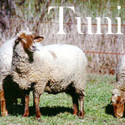The American Tunis evolved from a number of importations of fat-tailed sheep from Africa and the Middle East in the late 18th and early 19th centuries. These sheep were crossed with some established European breeds to improve the meat characteristics.
The earliest documented importation occurred in 1799. By the 1820’s, Tunis were in much demand by butchers in eastern Pennsylvania. Descendants of Judge Peters’ sheep, as well as additional importations of fat-tailed sheep became established in Maryland, Virginia, North and South Carolina, and Georgia. Thomas Jefferson imported “broad-tailed” sheep and kept them for many years. He preferred them over his Merinos for their mutton and wool-producing attributes. The breed was quite popular as in 1892, Ezra Carmen in a chapter of A Report of the Sheep Industry of the U.S. wrote, “But for the introduction of the fine-wooled Merino, these Tunisian sheep would probably have become disseminated throughout the U.S., and in some of them have become the prevailing flocks.”
INSTRUCTIONS: If you put cursor over a pin and click the breeders information will appear. On some of the breeders maps the pins are so close together on the zoomed out map that you can not see all the pins marking individual breeders. For those situations I recommend clicking on the blue words below the map to see a larger version that also shows the list of breeders in alphabetical order along the side.
View Tunis enrolled in a larger map



Sorry, comments are closed for this post.